Getting pregnant 101: a complete guide to safe and fast conception
- READING TIME 12 MIN
- PUBLISHED November 02, 2023
- AUTHOR Donna
Key takeaways
- It’s best if you start preparing for baby-making at least three months in advance. Your to-do list includes taking folic acid, examining your weight, quitting smoking and avoiding toxic environments.
- The fastest road to pregnancy is by having sex in your fertile window – timeframe which lasts around five days before and on the day of ovulation.
- Getting pregnant isn’t (always) plain sailing – at any age. In the most fertile years in your 20s, you only have between a 20- to 37-percent chance of getting pregnant during the first 3 months of trying. With age the odds of getting pregnant drop significantly.
- If trying to conceive naturally fails, many different fertility treatments can be used to overcome the causes of infertility – in both partners. We explain them in more detail below.
Getting pregnant 101: a complete guide to safe and fast conception
The baby-making process seems straightforward – first have sex, then get pregnant. Sometimes, it really is as simple as that, but for many couples, it will still take some planning, scheduling and patience. Don’t fret, however, you’re in the best possible place to learn everything you need to know about how to have a healthy, safe and possibly short road to pregnancy.
Fertile window 101
The fertile window is your monthly opportunity to conceive. The fertile window typically lasts for six days which includes the five-day lifespan of the sperm inside the female+ reproductive tract (they are resilient little swimmers) and the one day you ovulate. 1 If you plan to have a baby, the fertile window is when you should have unprotected sex. Equally important, if the baby is not on the agenda, play it extra safe in the days leading to ovulation. We invite you to jump over to our dedicated article to learn about the intricacies of the fertile window.
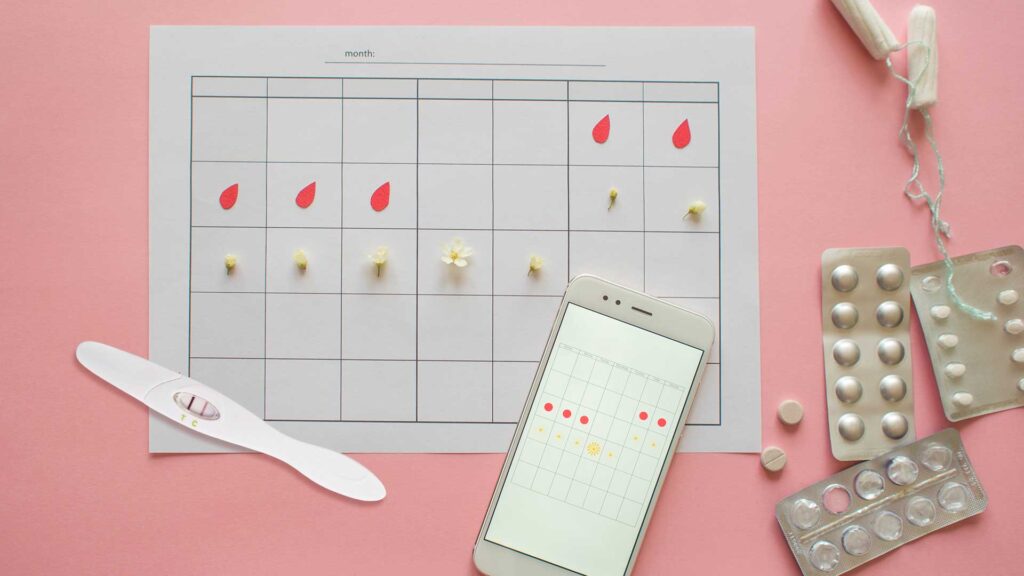
How to calculate your fertile window
To determine your fertile window, you’ll need to pinpoint the day you ovulate. If your menstrual cycle is standard and lasts for 28 days, you’ll ovulate on day 14 or sometime around that day. Most people who menstruate, however, don’t have a “normal” cycle and ovulation can occur anytime between 11 to 21 days after the first day of your last period. 2 If this is your case, you’ll need to deploy other methods and, thankfully, there are many efficient ways to track down ovulation.
How to track ovulation
Ovulation is the release of an egg from the ovaries. After the egg is released, it moves down the fallopian tube to meet the sperm for fertilization where it can survive for up to 24 hours. 3 If it doesn’t get fertilized, it disintegrates into the uterine lining and is discharged during your period.
As the great egg migration is underway, you may notice certain changes in your body. Vaginal discharge or cervical mucus becomes clearer and slippery, resembling a raw egg white. Breasts may become sore, nipples more sensitive and you may feel more sexually excited. 4 5 6
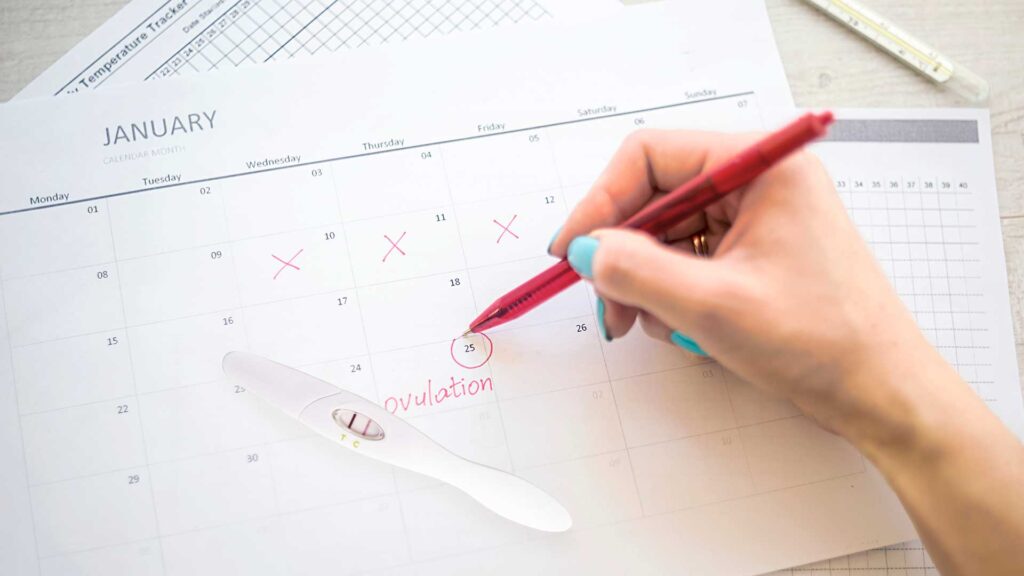
But a much more sophisticated tell-tale sign of ovulation is the increase of your basal body temperature – typically, it increases between 0.3 °C to 0.6 °C 7 during ovulation and in the second half of the cycle. This leads to a logical conclusion – by tracking your basal body temperature each day in the morning before you get out of bed, you can predict when you normally ovulate. To measure these slight differences in basal temperature you’ll need a special, more precise thermometer.
You can also use ovulation test kits. They’re used to detect the luteinizing hormone (LH) surge that happens before an egg is released. Ovulation kits use saliva or urine samples. High-quality ones can predict the release of an egg within hours.

When to have baby-making sex
Most fertile time and best time to have sex is a day or two leading up to ovulation. At this point, healthy sperm is likely to survive and will be waiting in the fallopian tubes for an egg to fertilize. If timing for sex is stressful for you (and we completely get that 8 ), don’t worry too much: doing it every second or third day will yield almost the same results. 9
Getting pregnant: the big dos and don’ts
Lifestyle changes
For best results start implementing changes to your daily routine at least three months before you begin with baby-making – or as long as you need to get your body ready for pregnancy. 10 Here are some key things you should consider:
- Stop smoking (avoid passive smoking, too) and doing any potential recreational drugs; 11
- Limit alcohol consumption;
- Discuss any prescription drugs you might be taking with your doctor to be sure they are safe;
- Avoid working with hazardous chemicals;
- Try to live a more stress-free life: doing yoga, meditation or going for a massage may help;
- Avoid drinking too much coffee as it may contribute to delayed conception; 12
- Try to get a good night’s sleep. Trouble sleeping at night was associated with “modestly reduced conception rates”. 13
Start taking folic acid
Folic acid is a vital prenatal vitamin and is known to prevent neural tube birth defects. The tube is completely formed 21 to 28 days after conception. 14 Neural tube defects affect around 300,000 babies worldwide each year. 15 It’s best if you start your folic acid routine three months before you jump into having unprotected sex. 16 17 18
Additionally, make sure that you pick an active form of folic acid known as “5-MTHF”. Many people (around 55 percent of Europeans) have a genetic mutation that limits their bodies to convert folic acid into an active, usable form. 19 An already active form will therefore work in people who are not able to convert folic acid themselves. To learn more about the different forms of folic acid, read our article or jump over to Donna’s active-form folic acid Qute.
In addition to folic acid, you may also want to consider supplements or a diet rich in iron, calcium, vitamin D and zinc. 20
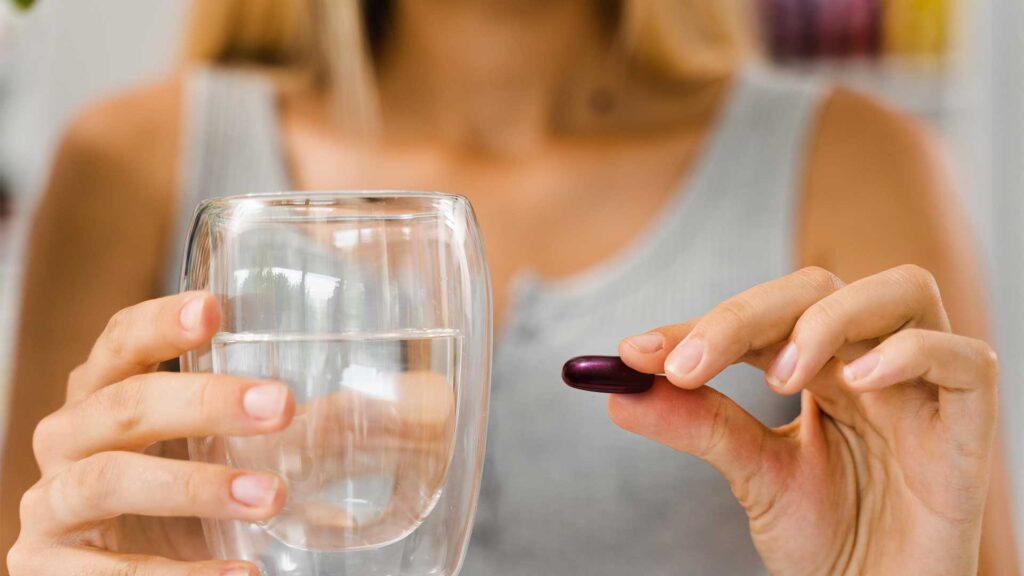
Start (or continue) a healthy diet
A big part of a healthy lifestyle is a balanced diet which includes green and leafy vegetables, fresh fruits, whole grains like buckwheat and brown rice, legumes and lean protein foods. 21

Keep a healthy weight
Too much body fat produces excess estrogen, which can interfere with ovulation. Obese couples will need considerably more time to become pregnant while being underweight may lead to hormone imbalance that affects ovulation. Gentle exercise, such as walking, prenatal yoga and pelvic floor exercise, is good for you during pregnancy, too – it helps you maintain a healthy weight and helps prepare your body for labor. 22
Consider your lube
Certain water-based vaginal lubricants can decrease the movement of sperm or even “kill” the sperm before it may have a chance to reach the egg. 23 Go for the natural way of lubrication with extra foreplay or look for sperm-friendly, natural lubes.
Additionally, washing the vagina with water or other fluids after sex may also sabotage your chances of getting pregnant.
All about (in)fertility
What are your chances of getting pregnant?
Getting pregnant isn’t (always) plain sailing – at any age. Even in the most fertile years in your 20s, you only have between a 20- to 37-percent chance of getting pregnant during the first 3 months of trying. 24 Most couples still conceive eventually – the chance of success increases to 80 percent if you work on a baby every month over the course of a year.

With age, however, the odds of getting pregnant drop. There’s a sharp decline in female+ fertility after age 37 and an even steeper after you hit 40. 25 As you grow older, you are also more at risk for certain reproductive-health related problems such as uterine fibroids, polycystic ovarian syndrome (PCOS), endometriosis or fallopian tube blockage. Other illnesses, including kidney disease, celiac disease and thyroid disease, may also contribute to loss of fertility if left untreated. 26 27
What else may affect fertility
There are many other factors that may contribute to female+ (in)fertility. If any of these affects you, talk to your doctor about the steps you should take:
- Abnormal and irregular ovulation: a condition medically known as anovulation where the egg is not released accounts for around 30 percent of all cases of infertility. The common symptoms of anovulation are irregular periods, absence of periods or abnormal bleeding. 28 29
- Smoking: cigarette smoke ages ovaries and depletes the egg reserve much faster. Up to 13 percent of infertility in women+ is caused by smoking. 30
- Obesity: being overweight can throw off hormone levels, which can impact the reproductive cycle, complicating the path to pregnancy. 31 , 32 Being underweight, on the other hand, can also cause problems by shutting down ovulation. 33
- Sexually transmitted disease: untreated STDs with gonorrhea and chlamydia as most common can lead to pelvic inflammatory disease which may cause permanent damage to the fallopian tubes, uterus and surrounding tissues, making it difficult or impossible to get pregnant. 34 STDs are usually fully treatable, so talk to your doctor if you suspect you have it.
- Excessive exercise: exercising too hard can affect baby-making. 35 On the other hand, regular and moderate exercise has positive effects. 36
- Premature ovarian failure: in most cases of premature ovarian failure, the cause is unknown, but in some people it may be caused by chromosome abnormalities or autoimmune diseases.37
How do fertility tests work
There are different ways of assessing fertility. Typically, doctors will first do a general assessment, which includes checking your body mass index and examining pelvic area for infection or lumps which could indicate fibroids, ovarian tumors or endometriosis.
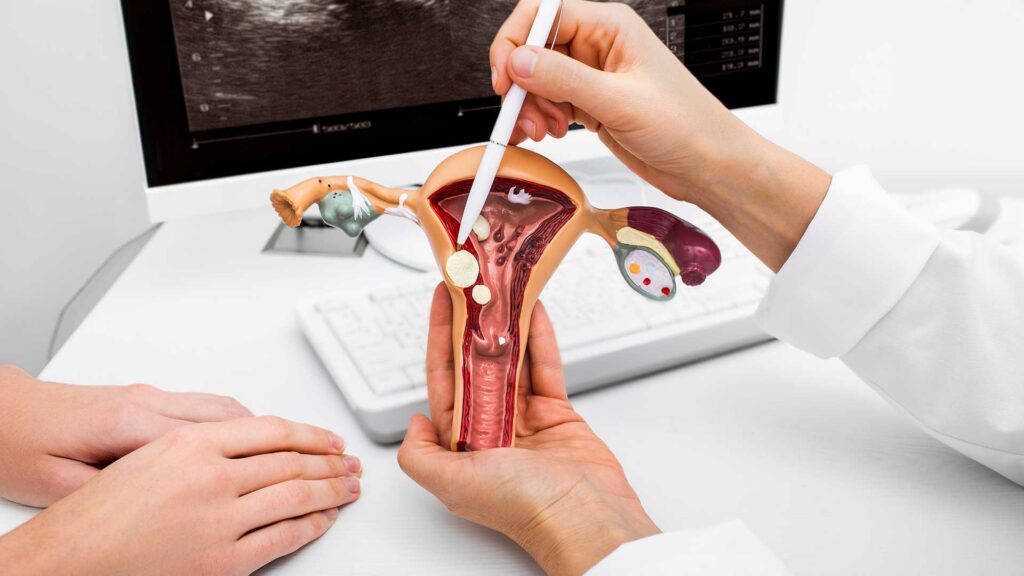
It’s always best for both partners to visit their doctors as fertility problems can affect either or both partners. 38
Additionally, doctors will do a blood test to measure progesterone levels. Progesterone is low during the follicular phase and then increases progressively to peak levels 6 to 8 days after ovulation. 39
If you have irregular cycles, timing your progesterone test is a bit more complex. In this case, an alternative is to do a test that measures gonadotrophins hormones, which stimulate the ovaries to produce eggs.
Other methods of testing fertility include:
- Tests for sexually transmitted diseases (STD) such as chlamydia which can affect fertility by causing pelvic inflammatory disease (PID); 40
- (Transvaginal) ultrasound scan to investigate your reproductive organs. If the results suggest abnormalities such as blockage, you may be directed to additional tests such as laparoscopy; 41
- Laparoscopy is conducted by making small cuts in your belly where doctors insert a special tool with a camera. This surgery can check your entire pelvis and potentially correct problems, such as endometriosis. Laparoscopy is usually only used if it’s likely that you have a problem; 42
- X-ray test called hysterosalpingography (HSG) is used to observe the size and shape of the uterus and see if the fallopian tubes are blocked. 43 44
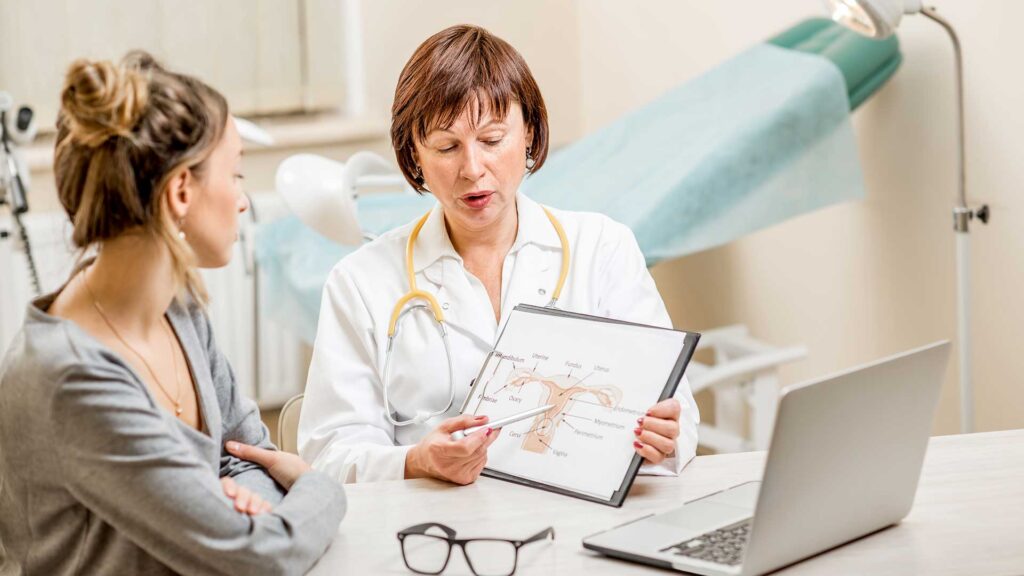
Understanding the options of fertility treatment
Things don’t always go exactly to plan. If trying to conceive naturally fails, many different fertility treatments can be used to overcome the causes of infertility – in both partners. Most couples start with the least invasive treatments like ovulation induction and only progress to more involved treatments if the basic ones aren’t successful.
To help encourage ovaries to release the egg, you may be prescribed different types of medication that help increase or decrease the production of certain hormones.
Surgery can help treat certain underlying conditions, such as blocked or scarred fallopian tubes, or by removing uterine fibroids or polyps.
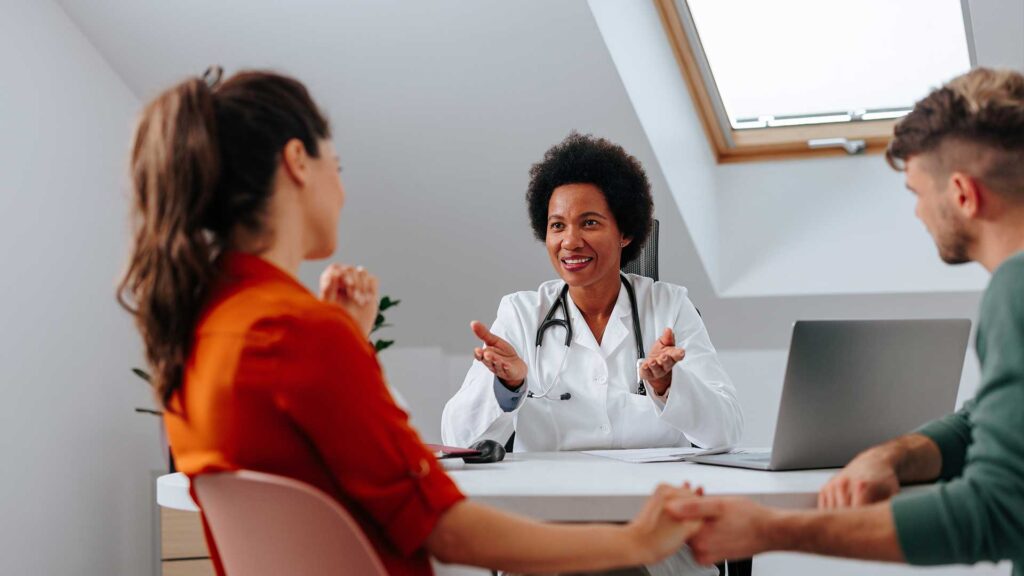
As the next step, many couples decide on assisted conception. The type of assistance depends on the causes of infertility, age and possible history of previous pregnancies. Here are your options and if you want to learn more about them, we welcome you to read our comprehensive article on fertility treatments.
- Intrauterine insemination (IUI): sperm is placed directly into the womb at the time of ovulation using a small catheter.
- In vitro fertilisation (IVF): eggs are retrieved from a woman’s+ ovaries and fertilized with sperm in a laboratory dish. The embryos are transplanted into the womb or can be frozen for future use.
- Intracytoplasmic sperm injection (ICSI): a somewhat similar process to IVF but in the case of ICSI, a selected sperm is injected directly into the egg in the lab. The embryo is then transplanted into the womb.
- Donated sperm: donor sperm is either injected into the uterus or used to fertilize eggs in the lab. This method is used if the man+ has a low sperm count or produces no sperm at all.
- Donated eggs: eggs of another woman+ can be combined with your partner’s sperm. The resulting embryo is then implanted in your womb.
- Surrogacy: another woman+ carries the baby to term. The embryo can also be donated.
Pre-conception checklist
The baby-making phase can be fun and exciting (for obvious reasons) but it also comes with certain responsibilities. To make things a bit easier for you, we condensed the key information into one big to-do list:
- Start taking folic acid
- Stop using contraceptives
- Schedule a pre-conception health check-up
- Start tracking your ovulation
- Discuss pregnancy history and family tree with your doctor
- In case of disease, start treatment
- Stay away from unsafe environments
- Reconsider your diet
- Examine your weight
- Start exercising
- Take up relaxation techniques for better sleep
- Schedule an appointment with a dentist
- Talk to your partner about their lifestyle habits
REFERENCES
- https://www.ncbi.nlm.nih.gov/pmc/articles/PMC27529/
- https://www.nature.com/articles/s41746-019-0152-7?utm_medium=affiliate&utm_source=commission_junction&utm_campaign=CONR_PF018_ECOM_GL_PHSS_ALWYS_PRODUCT&utm_content=textlink&utm_term=PID100052172&CJEVENT=05343162ba9811ec80f3013e0a180514
- https://www.thewomens.org.au/health-information/fertility-information/getting-pregnant/ovulation-and-conception
- https://journals.sagepub.com/doi/full/10.1177/1474704919848116
- https://www.mayoclinic.org/healthy-lifestyle/getting-pregnant/expert-answers/ovulation-signs/faq-20058000
- https://www.betterhealth.vic.gov.au/health/conditionsandtreatments/ovulation
- https://www.uofmhealth.org/health-library/hw202058
- https://bjui-journals.onlinelibrary.wiley.com/doi/abs/10.1111/j.1464-410X.2012.11577.x
- https://www.nhs.uk/pregnancy/trying-for-a-baby/trying-to-get-pregnant/
- https://www.marchofdimes.org/pregnancy/getting-ready-for-pregnancy-preconception-health.aspx
- https://link.springer.com/article/10.1186/s12958-020-0567-7
- https://pubmed.ncbi.nlm.nih.gov/7503053/
- https://pubmed.ncbi.nlm.nih.gov/30987736/
- https://academic.oup.com/ajcn/article/85/1/285S/4649476
- https://academic.oup.com/ajcn/article/85/1/285S/4649476
- https://www.tommys.org/pregnancy-information/planning-a-pregnancy/are-you-ready-to-conceive/benefits-taking-folic-acid-pregnancy
- https://www.mayoclinic.org/healthy-lifestyle/getting-pregnant/in-depth/preconception/art-20046664
- https://www.ncbi.nlm.nih.gov/pmc/articles/PMC3279093
- Francesco Scaglione & Giscardo Panzavolta (2014) Folate, folic acid and 5-methyltetrahydrofolate are not the same thing, Xenobiotica, 44:5, 480-488, DOI: 10.3109/00498254.2013.845705
- https://www.mayoclinic.org/healthy-lifestyle/pregnancy-week-by-week/in-depth/prenatal-vitamins/art-20046945
- https://www.stanfordchildrens.org/en/topic/default?id=nutrition-before-pregnancy-90-P02479
- https://www.nhs.uk/start4life/pregnancy/exercising-in-pregnancy/
- https://www.mayoclinichealthsystem.org/hometown-health/speaking-of-health/trying-to-get-pregnant-select-a-lubricant-that-is-most-helpful-for-sperm
- https://www.reproductivefacts.org/news-and-publications/patient-fact-sheets-and-booklets/documents/fact-sheets-and-info-booklets/optimizing-natural-fertility/
- https://www.livescience.com/55659-pregnant-at-age-40-50-and-even-60-here-are-the-risks.html
- https://www.acog.org/womens-health/faqs/having-a-baby-after-age-35-how-aging-affects-fertility-and-pregnancy
- https://my.clevelandclinic.org/health/diseases/16083-infertility-causes
- https://www.ncbi.nlm.nih.gov/books/NBK549773/
- https://www.ncbi.nlm.nih.gov/pmc/articles/PMC192851/
- https://www.reproductivefacts.org/globalassets/asrm/asrm-content/learning–resources/patient-resources/protect-your-fertility3/smoking_infertility.pdf
- https://pubmed.ncbi.nlm.nih.gov/32324768/
- https://health.clevelandclinic.org/does-being-overweight-affect-your-changes-of-getting-pregnant/
- https://www.betterhealth.vic.gov.au/health/conditionsandtreatments/weight-fertility-and-pregnancy-health#underweight-and-fertility
- https://www.cdc.gov/std/infertility/default.htm
- https://link.springer.com/article/10.2165/00007256-198907020-00002?fbclid=IwAR1uy9ywvj9azp4MT66-bdza6Du7XDJPg3B093IVImI9FGVbpDQsO_qjX8g
- https://academic.oup.com/humrep/article/35/3/676/5804223?login=true
- https://www.nhs.uk/conditions/early-menopause/
- https://www.nhs.uk/conditions/infertility/diagnosis/
- https://www.sciencedirect.com/topics/biochemistry-genetics-and-molecular-biology/progesterone-blood-level
- https://www.stanfordchildrens.org/en/topic/default?id=chlamydia-can-lead-to-infertility-1-2517
- https://www.ivf1.com/infertility-ultrasound/
- https://www.webmd.com/infertility-and-reproduction/guide/fertility-tests-for-women1
- https://www.mayoclinic.org/hsg-test/vid-20084751
- https://www.acog.org/womens-health/faqs/hysterosalpingography

